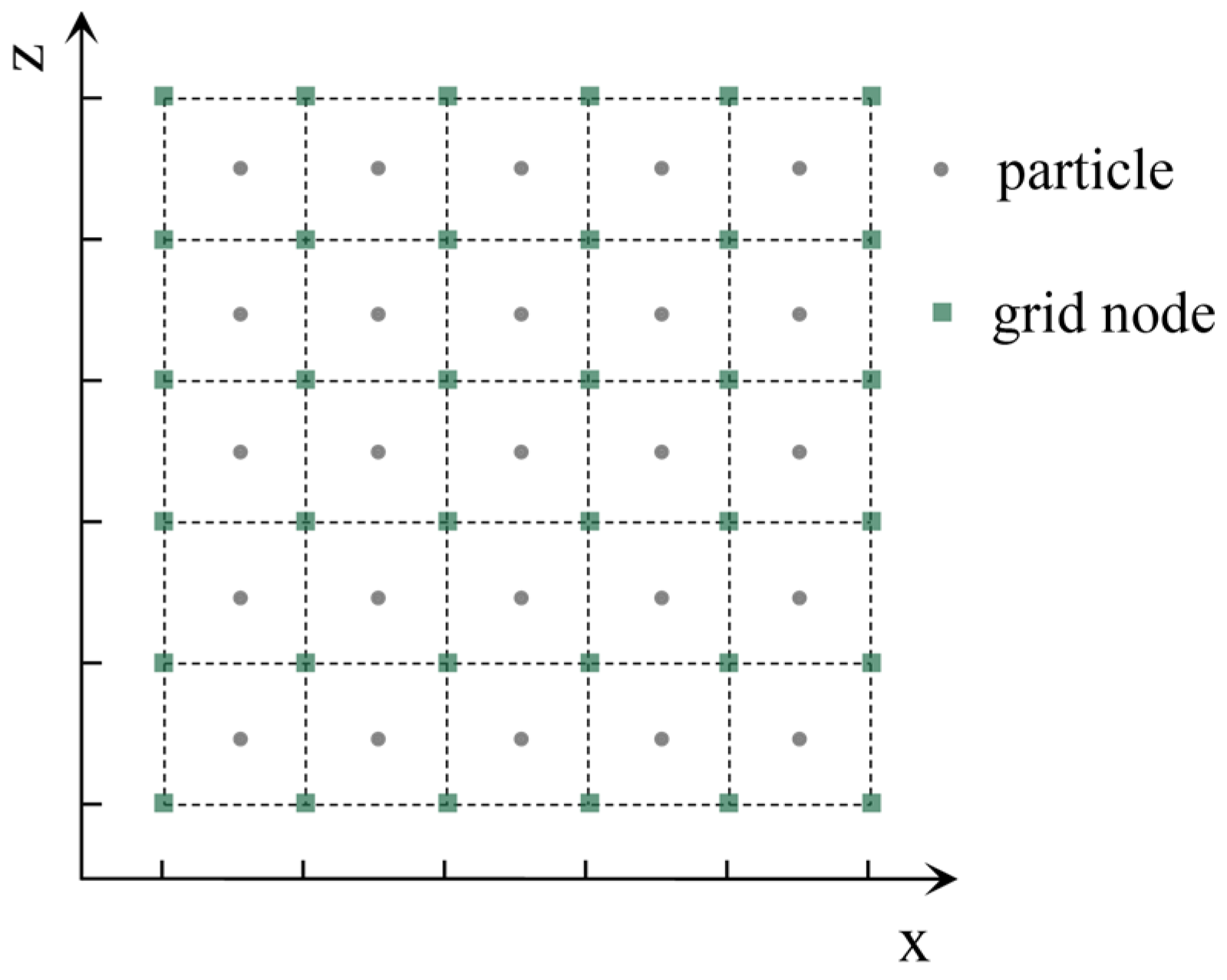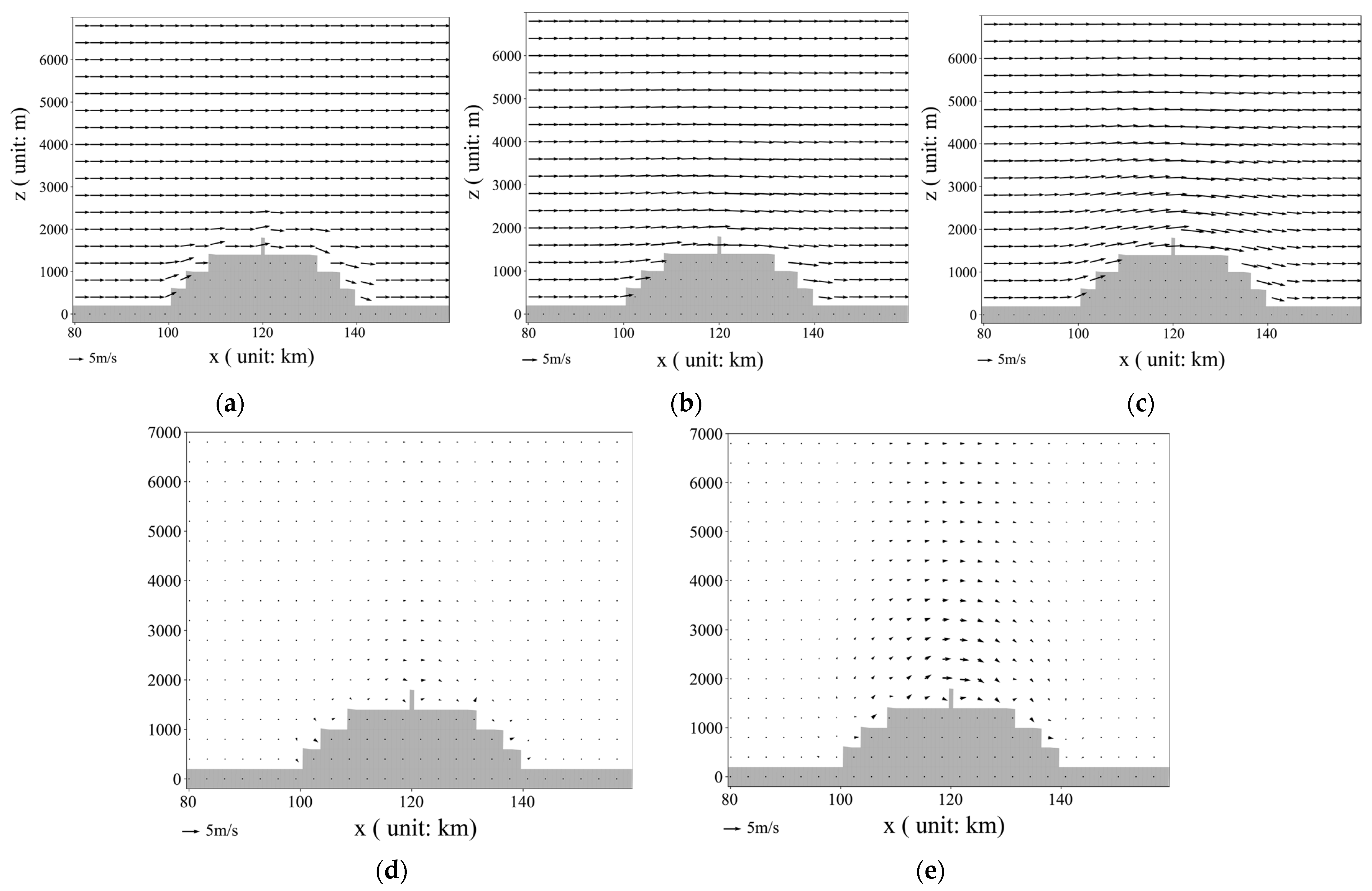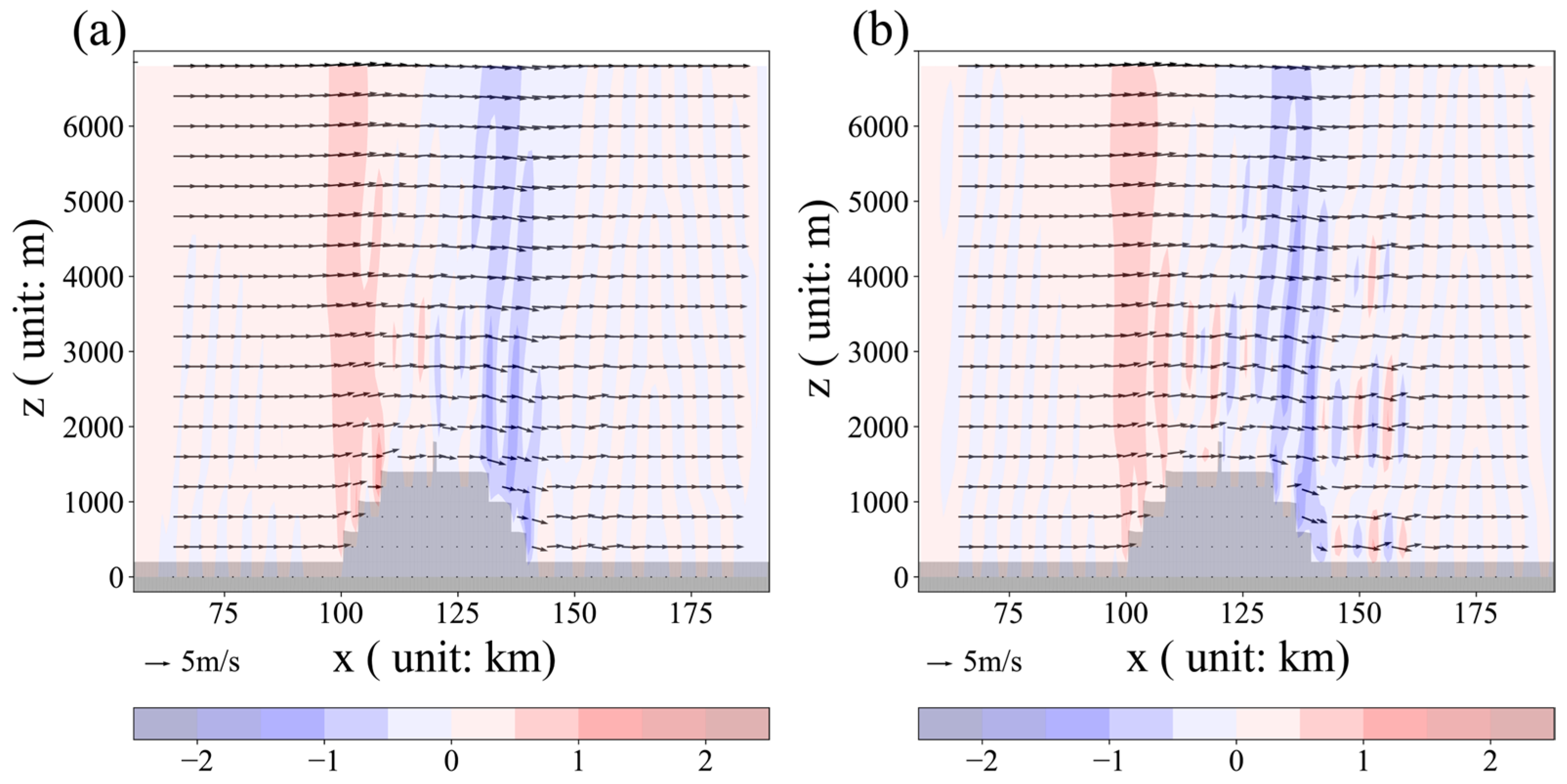Applicability Study of Euler–Lagrange Integration Scheme in Constructing Small-Scale Atmospheric Dynamics Models
Abstract
:1. Introduction
2. Model Design
2.1. Modeling Equations
2.2. Calculation of Spatial Gradient Forces
- (I)
- Deformation Calculation
- (II)
- Calculation of Pressure Gradient Forces
- (III)
- Calculation of Gradient Forces near Terrain
- (IV)
- Model Computation Process
- Calculation of particle deformation: particle coordinates are used to aggregate wind vectors from surrounding grid points, enabling the computation of particle deformation;
- Application of gradient forces from particle deformation to the background grid;
- Acquisition of acceleration by background grid points, with the acceleration projected onto particles;
- Update of particle velocities and calculation of particle displacement over a single time step;
- Update of background grid velocities.
2.3. Lagrange Method for Particle Motion Computation
- (I)
- Particle Motion
- (II)
- Mapping Particle Momentum to Adjacent Grid Points
- (III)
- Mapping Grid Point Momentum to Particles
2.4. Weight Calculation
2.5. Boundary Conditions
2.6. Model Grid Scheme
2.7. Time Step Constraint
2.8. Model Validation Scheme
2.9. Model Configuration
3. Results
3.1. Terrain Wind Characteristics
3.2. Simulation of Canyon Terrain Wind Fields
3.3. Model Computational Efficiency
3.4. Research Limitations
- Due to the difficulty in obtaining real-time data for small-scale meteorological wind fields and the fact that mainstream meteorological models are 3D models, while the model developed in this experiment is a 2D model, this paper compared the results by assuming virtual terrain conditions and using Fluent to simulate 2D flow fields.
- In practical downscaling processes, typically, a mesoscale model outputs a time series file every 3 to 5 min. Then, a downscaling model calculates the changes in atmospheric wind fields, temperature, and other physical processes within the 3 to 5 min interval. This process continues by reading new mesoscale data files for the next downscaling cycle. However, in this study, to test the model’s computational effectiveness and stability, an initial field was set, and the atmospheric state changes were estimated iteratively. The longest duration was 2500 s. Prolonged durations accumulate too much error, which affects the results.
- The main purpose of the experiments in this paper is to test the applicability of the Euler–Lagrange model under complex terrain conditions. The effectiveness of the theory and methods used in this paper awaits further validation through more extensive, representative, and rigorous experiments.
4. Discussion
5. Conclusions
- Employing the Euler–Lagrange integration scheme to establish an atmospheric dynamics model proves effective in addressing atmospheric motion processes under small-scale, complex terrain conditions.
- This paper innovatively uses particle representation to simulate air parcels, capturing atmospheric motion processes. Furthermore, these particles are endowed with physical properties, such as temperature, pressure, wind speed, and deformation degree, which play a crucial role in computing grid pressure gradient forces and simulating atmospheric motion states.
- Compared to traditional Euler methods, the Lagrange particle method exhibits more pronounced perturbations under micro-terrain conditions, aligning with the flow characteristics of small-scale meteorological models. Additionally, the Euler–Lagrange method accurately simulates “terrain waves” generated by mountain airflow, demonstrating its unique advantages in small-scale weather simulations.
Author Contributions
Funding
Institutional Review Board Statement
Informed Consent Statement
Data Availability Statement
Conflicts of Interest
References
- Groot, E.; Tost, H. Analysis of variability in divergence and turn-over induced by three idealized convective systems with a 3D cloud resolving model. Atmos. Chem. Phys. 2020. [Google Scholar] [CrossRef]
- Oreskovic, C.; Savory, E.; Porto, J.; Orf, L.G. Evolution and scaling of a simulated downburst-producing thunderstorm outflow. Wind Struct. 2018, 26, 147–161. [Google Scholar]
- Zhou, Y.; Li, X. An Analysis of Thermally-Related Surface Rainfall Budgets Associated with Convective and Stratiform Rainfall. Adv. Atmos. Sci. 2011, 28, 10. [Google Scholar] [CrossRef]
- Guo, Z.; Zhao, J.; Zhao, P.; He, M.; Yang, Z.; Su, D. Simulation Study of Microphysical and Electrical Processes of a Thunderstorm in Sichuan Basin. Atmosphere 2023, 14, 574. [Google Scholar] [CrossRef]
- Guo, J.; Liu, Y.; Zou, Q.; Ye, L.; Zhu, S.; Zhang, H. Study on optimization and combination strategy of multiple daily runoff prediction models coupled with physical mechanism and LSTM. J. Hydrol. 2023, 624, 129969. [Google Scholar] [CrossRef]
- Wang, Z.; Hao, W.; Han, C. Research on Improving Detection Capability of Small and Medium Scales Based on Dual Polarization Weather Radar. In Proceedings of the 2019 International Conference on Meteorology Observations (ICMO), Chengdu, China, 28–31 December 2019. [Google Scholar]
- Turner, R.; McConney, P.; Monnereau, I. Climate Change Adaptation and Extreme Weather in the Small-Scale Fisheries of Dominica. Coast. Manag. 2020, 48, 436–455. [Google Scholar] [CrossRef]
- Zhang, S.; Solari, G.; De Gaetano, P.; Burlando, M.; Repetto, M.P. A refined analysis of thunderstorm outflow characteristics relevant to the wind loading of structures. Probabilistic Eng. Mech. 2017, 54, 9–24. [Google Scholar] [CrossRef]
- Noh, I.; Lee, S.-J.; Lee, S.; Kim, S.-J.; Yang, S.-D. A High-Resolution (20 m) Simulation of Nighttime Low Temperature Inducing Agricultural Crop Damage with the WRF–LES Modeling System. Atmosphere 2021, 12, 1562. [Google Scholar] [CrossRef]
- Putnam, B.J.; Xue, M.; Jung, Y.; Zhang, G.; Kong, F. Simulation of Polarimetric Radar Variables from 2013 CAPS Spring Experiment Storm-Scale Ensemble Forecasts and Evaluation of Microphysics Schemes. Mon. Weather Rev. 2017, 145, 49–73. [Google Scholar] [CrossRef]
- Kurowski, M.J.; Wojcik, D.K.; Ziemianski, M.Z.; Rosa, B.; Piotrowski, Z.P. Convection-Permitting Regional Weather Modeling with COSMO-EULAG: Compressible and Anelastic Solutions for a Typical Westerly Flow over the Alps. Mon. Weather Rev. 2016, 144, 1961–1982. [Google Scholar] [CrossRef]
- Alexander, P.; Wolfgang, H. Mimetic Interpolation of Vector Fields on Arakawa C/D Grids. Mon. Weather Rev. 2019, 147, 3–16. [Google Scholar]
- Stephanie, W.; Oliver, F. A Locally Smoothed Terrain-Following Vertical Coordinate to Improve the Simulation of Fog and Low Stratus in Numerical Weather Prediction Models. J. Adv. Model. Earth Syst. 2021, 13, e2020MS002437. [Google Scholar]
- Xue, H.; Li, J.; Zhang, Q.; Gu, H. Simulation of the Effect of Small-Scale Mountains on Weather Conditions During the May 2021 Ultramarathon in Gansu Province, China. J. Geophys. Res. Atmos. JGR 2022, 127, e2022JD036465. [Google Scholar] [CrossRef]
- Ding, O.; Shinar, T.; Schroeder, C. Affine Particle in Cell Method for MAC Grids and Fluid Simulation; Academic Press: Cambridge, MA, USA, 2020. [Google Scholar]
- Jiang, C.; Schroeder, C.; Teran, J. An angular momentum conserving Affine-Particle-In-Cell method. J. Comput. Phys. 2017, 338, 137–164. [Google Scholar] [CrossRef]
- Cui, J.; Ray, N.; Acton, S.T.; Lin, Z. An affine transformation invariance approach to cell tracking. Comput. Med. Imaging Graph. Off. J. Comput. Med. Imaging Soc. 2008, 32, 554–565. [Google Scholar] [CrossRef] [PubMed]
- Stomakhin, A.; Schroeder, C.; Chai, L.; Teran, J.; Selle, A. A material point method for snow simulation. ACM Trans. Graph. (TOG) 2013, 32, 1–10. [Google Scholar] [CrossRef]
- Chang, X.; Guo, J.; Qin, H.; Huang, J.; Wang, X.; Ren, P. Single-Objective and Multi-Objective Flood Interval Forecasting Considering Interval Fitting Coefficients. Water Resour. Manag. 2024. [Google Scholar] [CrossRef]
- Grell, G.A.; Dudhia, J.; Stauffer, D.R. A Description of the Fifth-Generation Penn State/NCAR Mesoscale Model (MM5); Technical Report NCAR/TN-398+STR; National Center for Atmospheric Research: Boulder, CO, USA, 1994. [Google Scholar]
- Garcia-Dorado, I.; Aliaga, D.G.; Bhalachandran, S.; Schmid, P.; Niyogi, D. Fast Weather Simulation for Inverse Procedural Design of 3D Urban Models. ACM Trans. Graph. 2017, 36, 1–19. [Google Scholar] [CrossRef]
- Çelik, F.; Marwitz, J.D. Droplet spectra broadening by ripening process. Part I: Roles of curvature and salinity of cloud droplets. J. Atmos. Sci. 1999, 56, 3091–3105. [Google Scholar] [CrossRef]
- Heymsfield, A.J.; Sabin, R.M. Cirrus Crystal Nucleation by Homogeneous Freezing of Solution Droplets. J. Atmos. Sci. 1989, 46, 2252–2264. [Google Scholar] [CrossRef]
- Nakamura, K.; Matsumura, S.; Mizutani, T. Taylor particle-in-cell transfer and kernel correction for material point method. Comput. Methods Appl. Mech. Eng. 2023, 403, 115720. [Google Scholar] [CrossRef]
- Bai, S.; Schroeder, C. Stability analysis of explicit MPM. Comput. Graph. Forum 2022, 41, 19–30. [Google Scholar] [CrossRef]
- Qu, Z.; Li, M.; De Goes, F.; Jiang, C. The power particle-in-cell method ACM Transactions on Graphics. ACM Trans. Graph. 2022, 41, 1–13. [Google Scholar] [CrossRef]
- Tupek, M.; Koester, J.; Mosby, M. A momentum preserving frictional contact algorithm based on affine particle-in-cell grid transfers. arXiv 2021, arXiv:2108.02259. [Google Scholar]
- Nik, M.B.; Yilmaz, S.L.; Sheikhi MR, H.; Givi, P. Grid Resolution Effects on VSFMDF/LES. Flow Turbul. Combust. 2010, 85, 677–688. [Google Scholar] [CrossRef]
- Jiang, C.; Schroeder, C.; Selle, A.; Teran, J.; Stomakhin, A. The affine particle-in-cell method. ACM Trans. Graph. 2015, 34, 1–10. [Google Scholar] [CrossRef]
- Fu, C.; Guo, Q.; Gast, T.; Jiang, C.; Teran, J. A polynomial particle-in-cell method. ACM Trans. Graph. 2017, 36, 1–12. [Google Scholar] [CrossRef]
- Gupta, S.; Sharma, D.K.; Ranta, S. A new hybrid image enlargement method using singular value decomposition and cubic spline interpolation. Multimed. Tools Appl. 2022, 81, 4241–4254. [Google Scholar] [CrossRef]
- Zheng, Y.; Miao, Y.; Liu, S.; Chen, B.; Zheng, H.; Wang, S. Simulating Flow and Dispersion by Using WRF-CFD Coupled Model in a Built-Up Area of Shenyang, China. Adv. Meteorol. 2015, 2015, 528618. [Google Scholar] [CrossRef]
- Temel, O.; Bricteux, L.; van Beeck, J. Coupled WRF-OpenFOAM study of wind flow over complex terrain. J. Wind Eng. Ind. Aerodyn. 2018, 174, 152–169. [Google Scholar] [CrossRef]
- Choi, H.W.; Kim, D.Y.; Kim, J.J.; Kim, K.Y.; Woo, J.H. Study on Dispersion Characteristics for Fire Scenarios in an Urban Area Using a CFD-WRF Coupled Model. Atmosphere 2012, 22, 47–55. [Google Scholar] [CrossRef]
- Li, S.; Sun, X.; Zhang, S.; Zhao, S.; Zhang, R. A Study on Microscale Wind Simulations with a Coupled WRF–CFD Model in the Chongli Mountain Region of Hebei Province, China. Atmosphere 2019, 10, 731. [Google Scholar] [CrossRef]
- Engin, L.; Gokhan, A.; Tuncer, I.H. Wind potential estimations based on unsteady turbulent flow solutions coupled with a mesoscale weather prediction model. In Proceedings of the 7th Ankara International Aerospace Conference, Ankara, Turkey, 11–13 September 2013. [Google Scholar]
- Dong, W.; Fritts, D.C.; Hickey, M.P.; Liu, A.Z.; Lund, T.S.; Zhang, S.; Yan, Y.; Yang, F. Modeling Studies of Gravity Wave Dynamics in Highly Structured Environments: Reflection, Trapping, Instability, Momentum Transport, Secondary Gravity Waves, and Induced Flow Responses. J. Geophys. Res. Atmos. 2022, 127, e2021JD035894. [Google Scholar] [CrossRef] [PubMed]
- Parihar, N.; Taori, A. An investigation of long-distance propagation of gravity waves under CAWSES India Phase II Programme. Ann. Geophys. 2015, 33, 547–560. [Google Scholar] [CrossRef]
- Takayabu, Y.N. Large-scale cloud disturbances associated with equatorial waves. i: Spectral features of the cloud disturbances. J. Meteorol. Soc. Jpn. 1994, 72, 451–465. [Google Scholar] [CrossRef]
- Walterscheid, R.L.; Christensen, A.B. Low-latitude gravity wave variances in the mesosphere and lower thermosphere derived from SABER temperature observation and compared with model simulation of waves generated by deep tropical convection. J. Geophys. Res. Atmos. 2016, 121, 11900–11912. [Google Scholar] [CrossRef]
- Chan, P.W.; Lam, C.C.; Cheung, P. Numerical simulation of wind gusts in intense convective weather and terrain-disrupted airflow. Atmósfera 2011, 24, 287–309. [Google Scholar]

















| Time Consumption | Number of Iteration Time Steps |
|---|---|
| 27.96 s | 10 |
| 41.43 s | 20 |
| 89.94 s | 40 |
Disclaimer/Publisher’s Note: The statements, opinions and data contained in all publications are solely those of the individual author(s) and contributor(s) and not of MDPI and/or the editor(s). MDPI and/or the editor(s) disclaim responsibility for any injury to people or property resulting from any ideas, methods, instructions or products referred to in the content. |
© 2024 by the authors. Licensee MDPI, Basel, Switzerland. This article is an open access article distributed under the terms and conditions of the Creative Commons Attribution (CC BY) license (https://creativecommons.org/licenses/by/4.0/).
Share and Cite
Wei, X.; Liu, Y.; Guo, J.; Chang, X.; Li, H. Applicability Study of Euler–Lagrange Integration Scheme in Constructing Small-Scale Atmospheric Dynamics Models. Atmosphere 2024, 15, 644. https://doi.org/10.3390/atmos15060644
Wei X, Liu Y, Guo J, Chang X, Li H. Applicability Study of Euler–Lagrange Integration Scheme in Constructing Small-Scale Atmospheric Dynamics Models. Atmosphere. 2024; 15(6):644. https://doi.org/10.3390/atmos15060644
Chicago/Turabian StyleWei, Xiangqian, Yi Liu, Jun Guo, Xinyu Chang, and Haochuan Li. 2024. "Applicability Study of Euler–Lagrange Integration Scheme in Constructing Small-Scale Atmospheric Dynamics Models" Atmosphere 15, no. 6: 644. https://doi.org/10.3390/atmos15060644






